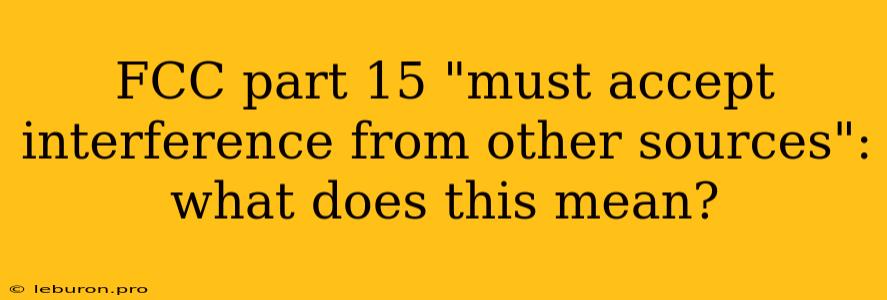The Federal Communications Commission (FCC) regulates radio frequency (RF) emissions in the United States, and its Part 15 rules are particularly important for electronic devices. One of the key aspects of these rules is the requirement that devices "must accept interference from other sources." This seemingly straightforward statement carries significant weight for both device manufacturers and consumers, defining the boundaries of RF compatibility and the expectations for device performance.
Understanding the Importance of FCC Part 15
FCC Part 15 governs the operation of unintentional or incidental radiators, which include a broad range of devices like computers, smartphones, Wi-Fi routers, and even Bluetooth speakers. These devices emit RF signals as a byproduct of their operation, and the FCC's regulations aim to ensure that these emissions don't cause harmful interference with other radio services.
The "Must Accept Interference" Principle
The phrase "must accept interference from other sources" is a fundamental principle within FCC Part 15. It acknowledges that the radio spectrum is a shared resource, and no single device can have exclusive rights to its usage. This principle ensures that various devices, from radio broadcasts to cellular networks, can operate without being disrupted by the emissions of other devices.
Why is Interference Acceptance Crucial?
- Spectrum Efficiency: By accepting interference, devices are less likely to cause disruptions in the radio spectrum, allowing for a higher density of devices and services to operate simultaneously.
- Technological Advancement: The principle encourages the development of devices that can coexist with other emissions, enabling the advancement of new technologies and services.
- Consumer Expectations: Consumers expect their devices to function reliably in a world with many RF sources, and the "must accept interference" principle helps ensure this.
Practical Implications of "Must Accept Interference"
The "must accept interference" principle translates into specific technical requirements for devices. This includes:
1. Emission Limits:
FCC Part 15 sets limits on the strength of RF emissions that devices can generate. These limits vary depending on the device type and frequency band it operates in. The goal is to ensure that the emissions from one device are not strong enough to interfere with other services operating in the same or adjacent frequency bands.
2. Compliance Testing:
Manufacturers are required to demonstrate that their devices comply with FCC Part 15 rules. This typically involves laboratory testing to measure the device's emissions and ensure they meet the established limits.
3. Labeling Requirements:
Products that comply with FCC Part 15 regulations typically display a label indicating their compliance. This label serves as a visual confirmation to consumers that the device has been tested and meets the FCC's requirements.
Examples of Interference and How Devices Adapt
The "must accept interference" principle plays out in numerous scenarios:
- Wi-Fi Interference: A Wi-Fi network can experience interference from other nearby Wi-Fi networks, Bluetooth devices, or even microwave ovens. This can lead to slow speeds or dropped connections. Modern Wi-Fi routers often employ features like channel selection algorithms and adaptive antenna technology to minimize interference and ensure reliable performance.
- Cellular Network Interference: Cellular networks can be affected by various sources, including industrial equipment, amateur radio transmissions, and even interference from other cell towers. The cellular industry utilizes advanced signal processing techniques and network optimization strategies to mitigate interference and maintain network stability.
- Bluetooth Interference: Bluetooth devices can experience interference from other Bluetooth devices operating in the same frequency band. This can lead to dropped connections or audio stuttering. Bluetooth devices employ frequency hopping techniques and adaptive power control to minimize interference and ensure reliable communication.
The "Must Accept Interference" Principle in Action
Understanding the "must accept interference" principle is crucial for both manufacturers and consumers. For manufacturers, it underscores the importance of designing devices that meet the FCC's technical requirements and minimize the potential for interference. For consumers, it provides assurance that the devices they use are capable of operating reliably in a complex radio environment.
Conclusion
The FCC's "must accept interference from other sources" principle is a fundamental aspect of the regulations governing the use of the radio spectrum in the United States. By ensuring that devices can coexist in a shared radio environment, this principle promotes spectrum efficiency, technological advancement, and consumer satisfaction. It is essential for manufacturers to design and test devices that meet these standards, and for consumers to be aware of the principle and its implications for device performance and compatibility. The "must accept interference" principle plays a vital role in the seamless operation of the numerous devices we rely on in our daily lives, ensuring the smooth functioning of radio services and enabling the development of future technological innovations.
